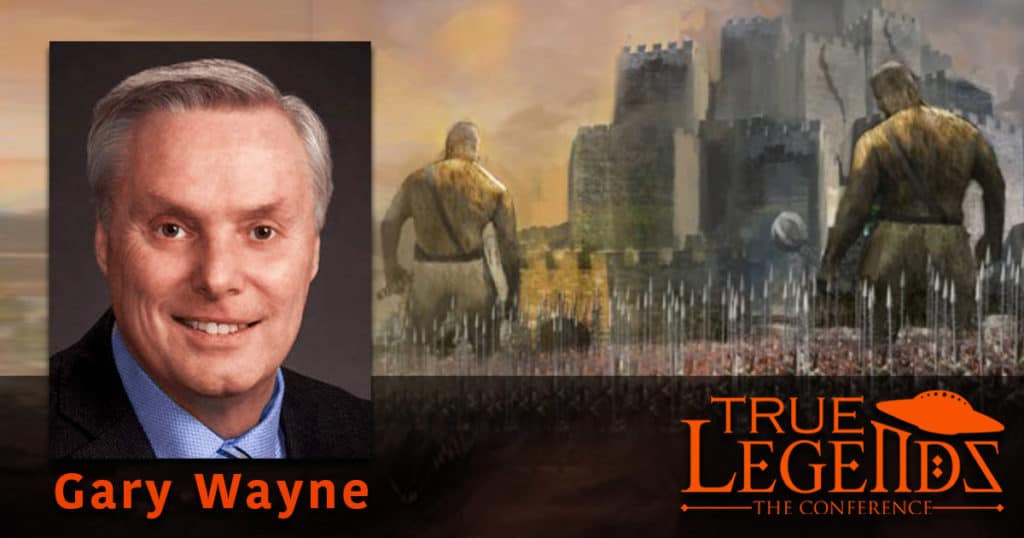Copyright © GenSix Productions 2024, All Rights ReservedSteve Quayle: “Brethren, I know most o...
(Scroll down to continue reading)
SQ Private Briefings subscribers: To clear up any confusion, you can continue to renew your SQ Private Briefings subscription annually with the card/payment method you already have on file.
Visit the "My Subscription" area of your account to see the status and renewal date of your subscription.
For more information view this FAQ

By Gary Wayne
Gaza was not conquered in the days of Joshua. Joshua did not drive out the five furtive Philistim lord (Jos 13:1-7). Further, the Philistim, Avvim and other nations of the Philistim confederacy were not included in Deu 7:1, or other passages listing the Seven Mighty Nations of Canaan.
More was going in the ancient Philistim land than most realize ─ a history steeped in giants; Israel’s nemesis nation not conquered until the days of David. The Philistim confederation might have been the most powerful and complex of all the Rephaim led nations of that era, reigning for a thousand years.
In this line of thought, Jos 11:22 curiously noted Anakim remained in two cities: Gaza and Gath of the Philistine lord’s pentapolis (Jos 13:2-3), noting Goliath’s home was Gath. The Avvim, like Anakim, and accounted as Rephaim (Deu 2:20-23) dwelt in the Hazerim, cities and villages of the Avvim up to Azzah, where the Caphtorim dwelled, which included Gaza city. The historically under-explained Caphtorim expropriated some of the Avvim land (Deu 2:23), and were somehow connected to the the Casluhim from which the Philistine people derived (1Chr 1:12).
The remnant of the Avites, Hebrew Avvim meaning inhabitants of Azzah driven out by Caphtorim, remained part of the Philistine lords and pentapolis in Gath and possibly Ekron and Askelon. (Jos 13:3). Lord is a unique appellation utilized 21 times to describe Philistine kings, which derives from ceren meaning lord, ruler, and tyrant.
Scholars believe ceren and transliterated plural seranim is not a Semitic word, but adopted into Hebrew from the Philistim language. Seranim’s etymology derives from and/or is equated with Greek tyrannous for tyrant─ one of many Greek links. Thus, Gyges king of Lydia was the first tyrannous noting Greek heroes were called gyges, the root word for giant and gigantic. Seranim was a Greek patronymic title for Avvim and Philistim rulers akin to Agag, Hadad, Jabin, and pharaoh.
The five seranim were a part of a bloodline governing council of Philistim princes ruling the confederation, just as the lords and princes are grouped together in 1Sam 29:2-9. Princes/Sar means chief, general, elder and/or a prince or ruler for a god in polytheist kingdoms. Conversely, Israelite prince(s) derive from nasiy, not sar, just as lord is generally adon, and not ceren as in lords of the Philistines. Thus, King Achish of Gath submitted to the kings of the Philistim council, sending David and his men away.
Knowing this brings context to the famous dual to the death between David and Goliath the giant Gittite from Gath, and one of the specific but important details. David selected five stones for is sling; not in case he missed, but in case he needed to slay four other Seranim kings from Gaza, Ekron, Ashdod, and Ashkelon (1Sam 17:40).
The Philistim confederacy was a superpower before the Israel’s conquest of the Covenant Land; defended by a complex network of fortress designed for perpetual war for both offense and defense. The network was described as fenced cities and country villages. Fences, mibtsar means castle, fortress and defended city or village (1Sam 6:18).
The Philistim complex network of village and city fortresses was reflected in the days of Saul when the Ark of the Covenant was returned by the Philistim lords with five golden emrods and five golden mice, noting the latter represented “the mice that mar the land” (1sam 6:4-5).
The Philistim city fortresses were the same kind cities recorded in Jabin’s northern Canaanite alliance─ part of Rephaim (that possibly included Avvim) fenced cities, mibtsar (Jos 19:35-36), as well as the Hazerim/chatseriym towns/cities of the Avvim (Deu 2:23). Jabin’s Hazor city derives from the singular chatsowr and chatser meaning a town protected by walls, as does the plural Hazerim/chatseriym.
The five emrods further represented the disease stricken Philistine pentapolis confederation: Ashdod, Gaza, Ashkelon, Gath, and Ekron (1Sam 6:17). Emrod means a tumour, pile, or disease representing in part the plague Philistines received for taking the Ark from Israel, while the five mice also represented “the number of lords” and cities of the Philistines, and which included the fenced villages (1Sam 6:4 &16-18).
The golden mice connected the five fenced city fortresses with the fenced villages reflecting the complex Philistine defense network. Mice/akbar means attacking and mouse, and is rooted in akkabiysh meaning entanglement, as in a spider weaving a network or web─ metaphoric for the military network of walled village fortresses supporting the five city-state strategy. The mice/akbar network is best described:
1SA 6.18 “And the golden mice, according to the number of all the cities of the Philistines belonging to the five lords, both of fenced cities, and of country villages”
The Philistim inherited this fortress network inherited from the Avvim or vice versa, and or from the Caphtorim of Hazerim (Deu 2:23). This fortress networked Philistim confederacy was not included in the War of Giants in Gen 14, perhaps because it was too powerful for the four Mesopotamian Kings.
The Philistim are first referenced in Gen 10:14 as posterity of Casluhim, son of Mizraim. Unger’s Bible Dictionary states Philistim derived from Egyptians shortly after Babel, the “Prst/Plst” who later left. Mizraim/Mitsrayim meaning Egypt inhabitant were the first Egyptian settlers, suggesting Philistim migrated to Gaza later, and aligns with Philistim located in Gaza and Gerar in Abraham’s time (Gen 10: 19 & 26:1).
Plishtiy is a transliteration of Pelishtiy: an inhabitant of Pelesheth, a Pelishite, and immigrant from Caphtor, noting Philistim is rooted in Plesheth meaning Palestine, immigrants, and land of sojourners. The Caphthorim/Kaphtoriym were immigrants from Crete, the original home of Philistines (Amo 9:4), all the while noting the Philistim were also called the remnant of the country of Caphtor (Jer 47:4), the island the Philistim migrated to from Egypt.
Philistim were a non-Semitic race, Aryans, according to Unger’s. Aryans are believed by some as surviving Atlantean giants, suggesting Philistim intermarried with Cretan gyge/giants producing hybrid Rephaim akin to Amorites, and the origin to the Seranim title. Supporting the Greek proto-Philistim notion are Rameses III’s Medinet Habu Reliefs (1150-1200 BC) that still depicted Philistim as very tall, Hellenic-looking race, while other depictions represented Philistim as clean-shaven with Cretan-styled helmets and tunics.
Philistim viciously expropriated the Gaza/Gerar regions, building their complex city-state and walled village network after the Avvim model or visa versa, and then were later accepted into the southern Rephaim alliance. Thus, Casluhim/Kacluchiym means fortified representing their fortress defence network. According to Americana Encyclopedia, Philistines built a confederation of cities, towns, peoples, and military poised for perpetual war.
In Gen 10:14 and 1Chr 1:11, Casluhim book-end the Philistim with the Caphtorim in the Table of Nations, which states Philistim derived from the Casluhim, followed by the (Cretan) Caphtorim as a related people to the Philistim. Philistim may have intermarried with Cretan Caphtorim giants to create the Philistim hybrid race before migrating to Gaza/Gerar.
Cherethim were another people grouped alongside Philistim (Eze 25:16 and elsewhere) and perhaps sheds even more light on Philistim scioned Rephaim bloodlines. Cherethim/Krethiyim means executioner, proto-Philistines, and a Cretan nation of mercenaries. Perhaps Cherethim were the key to creating the southern alliance with Rephaim made up of Avvim, Horim, an Amaleqim. Cherethim is rooted in Karath meaning to cut off, destroy, consume and/or make a covenant or alliance sworn to by mutual cutting of flesh─ an ancient blood oath Rephaim nations took to destroy Israel. Cherethim were grouped with Pelethite mercenaries as “mighty men”, Gibborim (2 Sam 20:7), often used to describe Nephilim in Gen 6:4.
Pelethites/Plethiy(im) were progeny of an unknown patriarch as were most Rephaim nations. One wonders whether the Caphtorim, Cherethim, and Pelethim were all Aryan Rephaim that Philistim interbred with along with the Avvim.
This was the formidable and furtive Philistine confederation, and military network Israel faced in the days of Judges; a Cretan superpower of hybrid giants/gyge backed by the Southern Rephaim alliance of Avvim, Horim, and Amaleqim. Judah did take on the Philistines taking Askelon, Ekron, and mountain regions, but did not defeat Philistines in the mountain valleys because of Philistine iron chariots (Jud 1:18-19). Later, God raised up Judges many times to lead Israel out of Philistim oppression: Othniel, Ehud, Shamgar, Deborah, Gideon, Tola, Jair, Jephthah, Ibzan, Elon, Abdon, Samson, Samuel and his sons Joel and Abiah.
The Philistim pentapolis flourished into the days of Saul and David. The pentapolis and lords were represented at the famous Shocoh dual between Goliath and David (1Sam 6:16-17). Goliath was 6 cubits and 1 span tall (1Sam 17:4). A span was 9”, a standard cubit 18”, while a royal cubit was 20.64-21”, which calculates Goliath was 9’9”-11’3”.
Goliath was a Gittite from the Avvim city Gath of the Philistine pentapolis, and one of the sons of a specific giant (Avvim) from Gath (1Chr 20:4-8). Giant translates from Rapha(im). Goliath was likely the Avvim king of Gath before Achish, or at least one of the princes/lords/Seranim of Philistine bloodline suggesting Goliath was likely 11’3” tall.
____
Gary Wayne, author of The Genesis 6 Conspiracy, is a Christian contrarian who has maintained a lifelong love affair with biblical prophecy, history and mythology. His extensive study has encompassed the Bible and Gnostic scriptures, the Qur’an, the Bhagavad Gita, Gilgamesh and other ancient epics, language etymology, and secret society publications. Gary Wayne is a speaker at True Legends The Conference 2020 in Branson, MO, July 10-12th.

Copyright © GenSix Productions 2024, All Rights ReservedSteve Quayle: “Brethren, I know most o...

Copyright © GenSix Productions 2024, All Rights ReservedSteve Quayle: “Brethren, I must start ...

Copyright © GenSix Productions 2024, All Rights ReservedSteve Quayle: “Brethren, I’m going t...

Copyright © GenSix Productions 2024, All Rights ReservedSteve Quayle: “Brethren, what we’ve ...

GenSix Productions was launched in 2014 with a mission to set the record straight giving an accurate historical and contemporary worldview based on the pivotal episode recorded in the sixth chapter of Genesis (as well as in many other ancient manuscripts and traditions). We believe that the narrative of Genesis 6 is the key to unlocking the secrets of the prehistoric past, and the cipher for decoding the mysteries of the prophetic future.
DISCOVER TRUE LEGENDS CONFERENCES